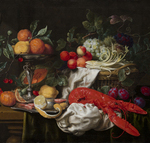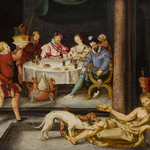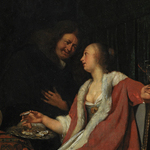Exhibition labels

166: The Fowl Market
This colossal canvas is a fantasy of nature’s bounty for its urban Flemish viewers. Deer, wild boar, hares, swan, pheasant, partridge, peacock, woodcock, kingfisher, skylark, blackbird, black grouse, bittern, snipe, and a string of songbirds, including bullfinch, chaffinch, and brambling,...

167-168: Pair of storage jars for mostarda fina
Pair of storage jars for mostarda fina (fruit pickle) Storage containers for preserved food often had substantial capacity like this vibrant pair for ‘Mostarda f[in]a’, a fruit pickle or sauce for culinary and medicinal purposes. Recipes usually included a purée...

169: Still life with a lobster
Still life with a lobster In early modern Europe, there was no choice but to eat seasonally, with food supply constrained by the seasons. With breathtaking realism, this painting combines foodstuffs that could never have been eaten at the same...

170: The Worship of the Golden Calf
The Worship of the Golden Calf This painting depicts the Old Testament story of the Israelites’ idolatrous worship of the golden calf. This narrative carried moralistic undertones, since excessive eating was deemed immoral, leading to the sins of Greed, Gluttony,...
171: Bartolomeo Scappi, Opera (Venice, 1622)
This page opening illustrates various tools, including a ‘sperone da pasticiero’, or a ‘pastry cook’s spur’. This was a multi-purpose pastry cutter (or ‘jagger’) with a large scimitar blade at one end, probably used for trimming, and a serrated wheel...
172: Georg Philipp Harsdörffer, Vollstandiges und von neuem vermehrtes Trincir-Buch (Nuremberg, 1657)
This is one of many manuals intended to instruct professionals in the arts of carving meat, fish, and fruit, and creating elaborate centrepieces from sugar-paste, butter, and starched and folded linens. These appeared in various languages all over Europe between...
173: Receipts of Pastry and Cookery
Edward Kidder, Receipts of Pastry and Cookery, For the Use of his Scholars (London, c.1720) This highly popular book provides a record of the lessons that ‘pastry master’ Edward Kidder offered at his two cookery schools in London, where gentlewomen...

174: Le Pâtissier (The Confectioner), from Les Métiers (Trades)
This engraving gives an evocative insight into the world of the Baroque pastry cook. Set in the bake-house of an elite French palace, one baker uses a peel to remove some finished pies from the oven, while his companion rolls...

180: Carving knife and fork
Carving in alto (aloft) was a spectacle enjoyed at elite tables. The highly skilled carver (trinciante in Italian) performed his sleight of hand by spearing the meat or fowl with the fork and slicing it cleanly with as few cuts...
175: Spirone di pasta
Spirone di pasta with scimitar blade and handle in form of a bird’s head Italy, c.1570 Bronze Private collection
176: Pastry jagger
Pastry jagger with finial in the form of a Dutch baker in guild dress Netherlands, c.1630 Brass Private collection
177: Pastry jagger
Pastry jagger (or rowle) with measuring spoon England, c.1660 Latten (alloy of copper and zinc) Private collection
178: Pastry jagger
Pastry jagger with pastry crimper and stamped design England, c.1720 Latten (alloy of copper and zinc) Private collection
179: Pastry jagger
Pastry jagger with finial incorporating a heart design England, c.1730 Latten (alloy of copper and zinc) Private collection The 5 pastry tools displayed here in chronological order are made from different materials in strikingly different forms, at different times, and...
Judaism, Food, and the Passover
Jewish life was – and still is – filled with opportunities to gather around the table and turn it into a mini Temple (Mikdash me’at), but it would be a mistake to conclude that Jewish food begins and ends with...
214: Seder plate (Qe’arah)
Seder plate (Qe’arah) made for Rabbi Mordechai (son of the late Rabbi Zalma Schwab) of Friedberg, and his wife, Bayle (daughter of Rabbi Abraham) of Marburg The Seder plate (Qe’arah), the focal point of the Passover meal, holds the symbolic...
Rabbi Mordechai’s Seder plate explained
Rabbi Mordechai’s Seder plate explained The 15 Hebrew 2019-12-04-s running around the inside of the plate indicate the order of the Seder meal: Kadesh (blessings of sanctification over a glass of wine) Urchatz (washing of the hands) Karpas (eating a...

213: Preparation for the Passover
Preparation for the Passover, from The Story of Moses and the Pharaoh This is the first Passover as described in the Old Testament (Exodus 12:11): on the eve of their escape from slavery in Egypt, the Israelites paint their doorposts...
215: Basin with five scenes from Genesis
This large basin is exquisitely decorated with scenes from Genesis, showing the key role of food in Man’s fall from grace to his first acts of sin: The Creation of Eve with abundant food freely given in the Garden of...

216: Adam and Eve in Paradise
Adam and Eve in Paradise The Fall was a popular subject as it provided artists with a legitimate excuse to depict a completely naked man and woman, a beautiful landscape, and all kinds of animals, highlighting their skills as well...

217: Still life with rotting fruit and nuts on a stone ledge
Many Dutch still lifes can be read as more than just brilliant illusionistic representations of nature. Mignon’s fruit – once luscious and beautiful but now spoiled and inedible – is typical of these sorts of vanitas paintings. They were designed...

218: Dives and Lazarus
Dives and Lazarus Gluttony was one of the Seven Deadly Sins, along with Pride, Greed, Lust, Envy, Wrath, and Sloth. Over-consumption of food was considered sinful if it meant that food was withheld from the needy, demonstrating a lack of...

219: Dutch courtship
Lust was another of the Seven Deadly Sins and, like Gluttony, often associated with food. Aside from its obvious inebriating qualities, wine was considered a ‘hot’ substance that generated sexual desire. The association of oysters with aphrodisiacs went back to...

220: A lady holding a plate with a waffle
A lady holding a plate with a waffle In this erotically-charged image, a beautiful young woman in a low-cut dress offers the viewer a waffle presented on a polished silver plate. With a knife in her other hand, she is...

221: Bridal tapestry with The Feast of Herod
The Feast of Herod Most likely made as a wedding present to decorate a new marital home, the brutality and sordid aspects of the blood-chilling story of Herod’s feast have been marginalised to leave a scene of multi-sensory feasting. Herod...
Christianity and Food
Christianity and Food Christians in early modern Europe were encouraged to eat in moderation, abstain from food at certain times in emulation of Christ’s self-denial, and share food with the less fortunate. The calendar of Church-prescribed fasting required Christians to...

212: Christ refusing the banquet
Christ refusing the banquet, from Paradise Regain’d The Romantic English poet and artist William Blake illustrated Christ’s asceticism and self- denial in this watercolour, one of a series inspired by John Milton’s 1671 poem Paradise Regain’d. Despite the temptations of...

222: Nine tiles, each depicting a Biblical scene connected to food
Top row, left to right: The Creation of Adam (C.2804.1-1928) The Fall (C.2804.2-1928) The Expulsion from Eden (C.2804.3-1928) Middle row, left to right: Cain killing Abel (C.2804.4-1928) Jacob giving Esau the Mess of Potage (C.2804.9-1928) The Sons of Job Feasting...
223: Plaque depicting The Last Supper
Although many images displayed in this room reflect the dark connotations of food as a dangerous gateway to iniquity, eating played a vital role in the drama of Christian redemption. This devotional plaque shows The Last Supper, Jesus’ final meal...
224: Plaque depicting The Lord’s Prayer
Plaque depicting The Lord’s Prayer: ‘Give us today our daily bread’ This plaque depicts the fourth petition in the Lord’s Prayer: ‘Give us today our daily bread’. This was interpreted from early Christianity as referring to three types of bread:...





